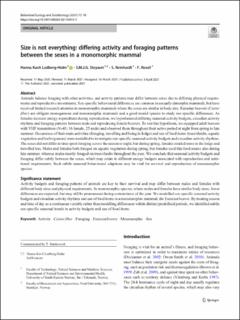| dc.contributor.author | Lodberg-Holm, Hanna Kavli | |
| dc.contributor.author | Steyaert, Sam | |
| dc.contributor.author | Reinhardt, Stefanie | |
| dc.contributor.author | Rosell, Frank Narve | |
| dc.date.accessioned | 2022-06-21T11:49:11Z | |
| dc.date.available | 2022-06-21T11:49:11Z | |
| dc.date.created | 2021-05-06T16:21:51Z | |
| dc.date.issued | 2021 | |
| dc.identifier.citation | Lodberg-Holm, H. K., Steyaert, S. M. J. G., Reinhardt, S. & Rosell, F. (2021). Size is not everything: differing activity and foraging patterns between the sexes in a monomorphic mammal. Behavioral Ecology and Sociobiology, 75(4), Artikkel 76. | en_US |
| dc.identifier.issn | 0340-5443 | |
| dc.identifier.uri | https://hdl.handle.net/11250/2999820 | |
| dc.description.abstract | Animals balance foraging with other activities, and activity patterns may differ between sexes due to differing physical requirements and reproductive investments. Sex-specific behavioural differences are common in sexually dimorphic mammals, but have received limited research attention in monomorphic mammals where the sexes are similar in body size. Eurasian beavers (Castor fiber) are obligate monogamous and monomorphic mammals and a good model species to study sex-specific differences. As females increase energy expenditure during reproduction, we hypothesized differing seasonal activity budgets, circadian activity rhythms and foraging patterns between male and reproducing female beavers. To test this hypothesis, we equipped adult beavers with VHF transmitters (N=41; 16 female, 25 male) and observed them throughout their active period at night from spring to late summer. Occurrence of their main activities (foraging, travelling and being in lodge) and use of food items (trees/shrubs, aquatic vegetation and herbs/grasses) were modelled to investigate sex-specific seasonal activity budgets and circadian activity rhythms. The sexes did not differ in time spent foraging across the season or night, but during spring, females resided more in the lodge and travelled less. Males and females both foraged on aquatic vegetation during spring, but females used this food source also during late summer, whereas males mostly foraged on trees/shrubs throughout the year. We conclude that seasonal activity budgets and foraging differ subtly between the sexes, which may relate to different energy budgets associated with reproduction and nutritional requirements. Such subtle seasonal behavioural adaptions may be vital for survival and reproduction of monomorphic species. | en_US |
| dc.language.iso | eng | en_US |
| dc.rights | Navngivelse 4.0 Internasjonal | * |
| dc.rights.uri | http://creativecommons.org/licenses/by/4.0/deed.no | * |
| dc.title | Size is not everything: differing activity and foraging patterns between the sexes in a monomorphic mammal | en_US |
| dc.type | Peer reviewed | en_US |
| dc.type | Journal article | en_US |
| dc.description.version | publishedVersion | en_US |
| dc.rights.holder | © The Author(s) 2021. | en_US |
| dc.source.volume | 75 | en_US |
| dc.source.journal | Behavioral Ecology and Sociobiology | en_US |
| dc.source.issue | 4 | en_US |
| dc.identifier.doi | https://doi.org/10.1007/s00265-021-03010-7 | |
| dc.identifier.cristin | 1908605 | |
| dc.source.articlenumber | 76 | en_US |
| cristin.ispublished | true | |
| cristin.fulltext | original | |
| cristin.qualitycode | 2 | |

